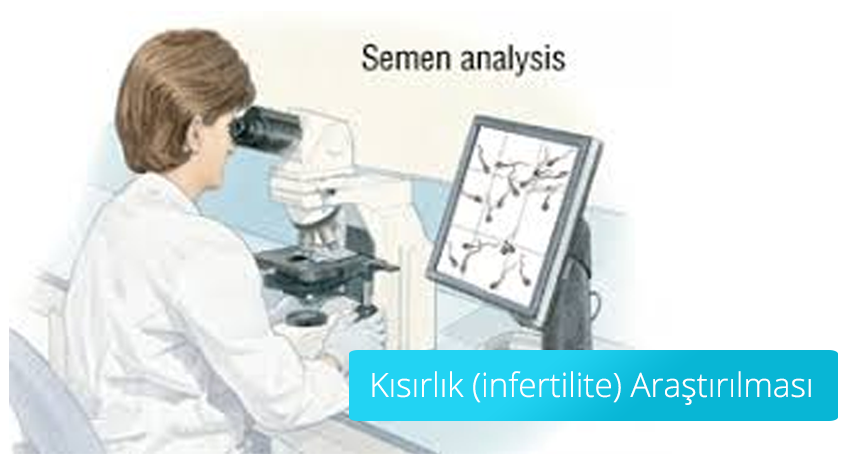Current Infertility Diagnosis and Treatment Options
Infertility is generally defined as the inability to achieve pregnancy despite the regular, unprotected relationship of a couple for one year. The first test to investigate infertility is semen analysis and should be repeated at least twice at 2-month intervals. If the semen analysis is normal, it is accepted that there is no problem in male infertility.
Sperm Analysis (Spermiogram)
There are some things to consider when giving semen for examination: A sperm sample should be given at least 3 days after sexual intercourse or ejaculation, and no later than 5 days. Materials such as saliva, soap or shampoo should not be used in order to lubricate the sample and the semen should be taken to a clean container and delivered to the laboratory to be examined within 60 minutes at the latest.
In sperm analysis, the amount of semen, acidity, number of sperm in milliliters, motility of sperm, structures and round cells are evaluated. Antisperm antibody tests and microbiological examinations are performed if necessary
Simen analysis should be performed to determine whether the woman ovulates. For this purpose, 19-21. A simple hormone test (progesterone) can be performed between the days of ultrasound or LH measurements in urine can be done.
What is infertility?
If pregnancy cannot be achieved within a period of one year despite the regular intercourse performed 2-3 times a week, it can be mentioned that there is infertility. If pregnancy does not occur within the first six months of marriage, couples do not need to apply to the physician immediately.
What tests are used to understand the cause of infertility?
With the ‘spermiogram test yapılan performed for the purpose of providing pregnancy, male problems can be clarified to a great extent. The tests applied to women provide a more detailed assessment of women’s problems. When evaluating the female factor; ovaries and the presence of ovulation, the condition of the tubes and problems with the uterus are being investigated. When the diagnostic examinations are completed, the majority of couples are diagnosed and the treatment options for the cause are preferred.
It is important for both men and women to come together to investigate an infertile couple. In the meantime, previous examinations and films of the couple, if any, are evaluated.
What are the current infertility treatments?
Investigation of the infertile couple starts with the examination of the male factor.


Infertility is a serious problem affecting about 15 percent of the reproductive age population worldwide. Infertility is a condition that affects men and women equally. About 30 percent of couples experiencing inability to have children have both female and male problems.
Current infertility diagnosis and treatment methods can solve most of these problems. However, one of the biggest obstacles to this is the age of couples being too late for diagnostic applications. However, the problem of infertility can be solved with early diagnosis and appropriate treatment options. Especially men can lose time seriously. Many of the causes of male infertility detected at an early age, the problem can be solved without serious.
How long does it take to start infertility treatment?
In terms of infertility treatment, a waiting period of at least one year is required before starting treatment. Because even in couples without any problems, the monthly pregnancy rate is approximately 25 percent. At the end of the 1 year period, the pregnancy rate is 80 percent. Therefore, it is appropriate for couples to wait for 1 year.
Is the waiting time for infertility treatment the same for people of all ages?
Since the age of the woman plays an important role in pregnancy; The waiting period should be 6 months for women over the age of 35, and for women over the age of 40, if a pregnancy is desired, a center should be consulted without waiting.
Do the causes of infertility vary between men and women?
Infertility should be separated from the causes of men and women. In men, sperm production problems come first. Inadequate or insufficient number of sperms, movement and deformity of sperms can prevent pregnancy significantly. In addition, causes such as sexual dysfunction, inflammation of the male reproductive tract and systemic diseases can lead to infertility. In women, ovulation problems, inflammation or obstruction in the tubes, anatomical disorders in the tubes, uterine fibroids and polyps, as well as problems with endomerosis, goiter diseases and diabetes can prevent pregnancy.
Is the same treatment method preferred for everyone?
Infertility problems are treated according to the cause. In male infertility patients are evaluated by urologists. Existing problems can be treated with medications or surgical methods. Pregnancy can be achieved by assisting reproductive methods such as vaccination or in vitro fertilization if male infertility is not answered. In women, the likelihood of pregnancy can be increased in many cases by medical or surgical methods.
Is the cause of infertility absolutely understandable?
About 10-15 percent of all infertile couples have no problems with women or men. This condition is called bilinmeyen unexplained infertility bilinmeyen or bilinmeyen unexplained infertility ‘. It is sometimes very difficult for a couple who have been diagnosed with unexplained infertility to accept this diagnosis.
95% of women who have regular menstruation normally lay eggs. Therefore, even the good questioning of the menstrual order will be illuminating in terms of ovulation alone.
One of the most important tests in women is the determination of ovarian capacity. For this purpose, during the menstrual period, an ultrasound is performed by vaginal route and the primordial follicles in the ovaries (tiny cysts suitable for development containing eggs) are counted.
Presence of less than 6 primordial follicles in two ovaries is a strong finding that ovarian capacity is decreased. In women, the ovarian capacity begins to decrease from the age of 37, and it becomes very difficult for a woman to have children after 44 years of age. Sometimes ovarian capacity decreases earlier.
Ovarian capacity needs to be carefully evaluated, especially in women with early menopause in the family, women who have had cysts from their ovaries, women with single ovaries, women with a history of endometriosis, young vicious couples, and couples with recurrent abortions.
In couples whose semen analysis and ovulation are evaluated, it is investigated whether the tubes are open or not. For this, the uterine tube film (HSG-hysterosalpingography) should be taken.
Hormonal tests used to evaluate women:
FSH, LH, E2, Prolactin, FreeT4, TSH, Free Testosterone, 17-OHProgesterone, DHEA-SO4, Androstenedione
Semen analysis, ovulation and ovarian capacity in couples with normal openness of the woman’s tubes are evaluated. For this, medicated uterine film (HSG-hysterosalpingography) is taken immediately after the end of menstruation (before ovulation). In this period, the uterus is seen better and after the ovulation period, a possible early pregnancy is not damaged. The uterine cavity and tubes are evaluated with HSG. It is seen whether the tubes are open and if they are closed to what level they are closed, but HSG does not give information about whether the tubes are open but does not give information about the function of the tubes.
HSG (Uterine Film)
HSG is a simple and often painless procedure, which can sometimes cause cramps in the uterus due to the rapid and pressurized administration of the drug. HSG is less likely to understand the adhesions and their severity in the abdomen. Hysteroscopy is used to evaluate and treat intrauterine adhesions, fibroids and intrauterine polyps if there are irregularities or filling defects in the edges of uterine cavity, deformity or structural disorder in the uterus. Hysteroscopy is the endoscopic examination of the cervix by inserting the fiberoptic light source device into the cavity through the cervix.
In general, laparoscopy is performed for suspected cases in HSG, inexplicable infertility, genital organ anomalies, pelvic pain and menstruation. Laparoscopy is the procedure of examining the abdominal organs by inserting a fiberoptic system illuminated by cold light source into the abdominal cavity.
Although HSG is a simple and often painless procedure, it can technically cause uterine cramps due to the rapid and pressurized administration of the drug. The procedure should be done immediately after the end of the period. In this way, the intrauterine is better seen and the possibility of a very early pregnancy after the ovulation period is eliminated.
The uterine cavity and tubes are evaluated with HSG. It can be understood whether the tubes are open and if they are closed at what level they are closed. In particular, the fact that a single tube is closed from where it is adjacent to the uterus is sometimes due to contraction of the tube as a result of the prescribed pressure of the drug. In this case there is a false congestion, not real.
HSG is less likely to understand the adhesions and their severity in the abdomen. HSG does not provide information about whether tubes are open or not, but does not provide information about the function of the tubes.
Laparoscopy can be performed in a woman who does not have any history and physical examination for abdominal pain.
Although laparoscopy is a frequently used technique in the past, it is now more limited in diagnostic use.
There are also tests that have been used in infertility studies but have not been proven.
These include immunological investigations (antisperm antibodies) and postcoital testing (examination of the cervix for the presence of sperm after intercourse).
As the results do not change the treatment approaches, they are almost never used today.


Add Your Comment